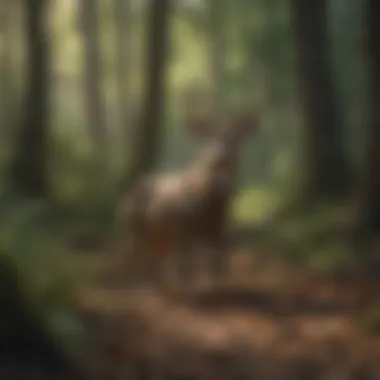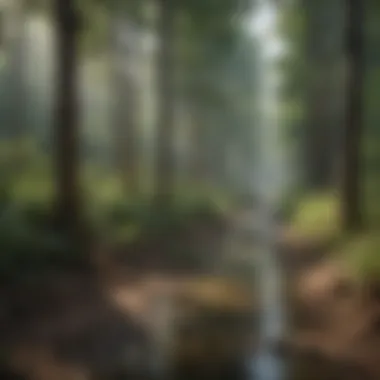Midwest Endangered Species: Biodiversity Crisis


Intro
The issue of endangered species in the Midwest is increasingly urgent, demanding thorough attention and understanding. Over the years, numerous species have found themselves on precarious paths toward extinction. This situation not only affects the specific species but also profoundly influences the entire ecosystem and biodiversity. Recognizing the driving factors behind this decline is essential for crafting effective conservation efforts.
From habitat loss to climate change, various elements create challenges for the survival of these species. As we delve into the complexities surrounding endangered species in this unique geographic area, we will explore the underlying causes, conservation initiatives, and implications for the environment. Understanding these elements is critical for maintaining the delicate balance of nature in the Midwest.
In today's narrative, we will guide you through the many dimensions of this topic, highlighting the specific species at risk, the reasons for their decline, and steps that can be taken to assist in their preservation. The conversation around endangered species in the Midwest is not just an environmental concern; it is an issue that touches on ethics, economics, and public policy.
It is throughout this exploration that we aim to foster a deeper awareness and appreciation for these species' importance and the need for collective action to protect biodiversity.
Foreword to Endangered Species in the Midwest
The Midwest region of the United States holds unique ecosystems, rich in biodiversity. However, this diversity is increasingly under threat. Understanding the plight of endangered species in this region is crucial. It illuminates the interconnectedness of ecosystems and the human impacts affecting them.
Defining Endangered Species
Endangered species are those at risk of extinction. The classification of a species as endangered typically considers several factors, including population size, habitat range, and threats faced. In the Midwest, many species face a combination of habitat loss, climate change, and competition from invasive species. The precise definition can vary by region, but the core concept remains the same: these species require urgent attention to prevent their extinction.
The Significance of the Midwest Region
The Midwest is a crossroads of diverse habitats, from prairies to wetlands. This variety supports numerous species, making it a biodiversity hotspot. However, its significance extends beyond regional richness. The Midwest plays a vital role in broader ecological processes. It acts as a migratory pathway for many species and harbors critical genetic resources.
The region has historically been subject to anthropogenic pressures such as agriculture and urban development. The effects of these activities on local wildlife cannot be overstated. Protecting endangered species in the Midwest not only conserves specific organisms but fortifies entire ecosystems. Thus, addressing endangered species in this region is a step towards maintaining ecological integrity nationwide.
Biodiversity in the Midwest: An Overview
Biodiversity in the Midwest is a critical element that reflects the ecological health of the region. This area is home to a wide range of ecosystems, such as prairies, forests, wetlands, and rivers. Each of these ecosystems hosts unique species, many of which are found nowhere else. This richness supports not only the species themselves but also the overall landscape's resilience against environmental changes. A healthy biodiversity is essential for providing ecosystem services, such as clean air and water, soil fertility, and pollination. In the context of endangered species, preserving biodiversity is particularly pressing, as the loss of any species can have profound and cascading effects.
Biodiversity is not just an academic concept; it has practical implications for agriculture, forestry, and urban planning. High biodiversity can lead to increased productivity and stability in ecosystems, which is crucial for human livelihoods. Moreover, diverse ecosystems are better able to withstand disturbances like invasive species or climate fluctuations. Thus, monitoring and conserving biodiversity in the Midwest should be a shared priority for community stakeholders and conservationists.
Ecosystems of the Midwest
The ecosystems within the Midwest are distinct yet interrelated. These ecosystems vary widely from the tallgrass prairies in states like Illinois and Iowa, to the deciduous forests that spread across Indiana and Ohio. Each ecosystem supports a diverse array of flora and fauna. For instance, prairies are not only home to grasses but also to numerous bird and insect species that rely on these habitats for sustenance and shelter.
In wetlands, the presence of water supports species like the endangered Indiana bat and various amphibians. These ecosystems play a vital role in local water cycles and act as natural buffers against flooding. However, many of these ecosystems face significant threats from urban development, agriculture, and pollution, severely impacting their biodiversity.
Understanding the specifics of these ecosystems is essential for identifying which species are most vulnerable and in need of protection.
The Role of Biodiversity
Biodiversity serves several key roles in maintaining the health of ecosystems. It provides stability and resilience, which can be particularly important in times of environmental change. A diverse ecosystem is typically more productive, as different species exploit various resources in complementary ways. This cooperative interaction leads to improved nutrient cycling and energy flow.
Biodiversity also underpins ecosystem services, which directly benefit humans. For example, having a variety of plant species ensures pollination for crops, essential for agricultural systems. Furthermore, biodiversity contributes to cultural values and recreational opportunities, adding intangible benefits to our communities.
To safeguard these critical roles, concerted efforts must be made at all levels—from governing policies to community education initiatives.
"The loss of biodiversity undermines nature's ability to deliver a range of vital services to humanity. Protecting biodiversity is not just an environmental issue, but a fundamental aspect of sustainable development."
Recognizing and addressing the threats to biodiversity in the Midwest is paramount for both ecological and human wellbeing.
Identifying Endangered Species in the Midwest


The identification of endangered species in the Midwest is fundamental to understanding the broader implications for biodiversity. In this region, numerous species face varying degrees of risk, largely due to human activities and environmental changes. Recognizing these species is the first step in implementing effective conservation strategies. Protecting endangered species fosters a healthier ecosystem, as each species plays a unique role in its environment. A decline in any one species can have a cascading effect, impacting numerous other organisms.
Understanding the specific characteristics, ranges, and habitats of these species is critical. This knowledge allows stakeholders, including conservationists, policymakers, and the general public, to formulate informed strategies for preservation and management. Endangered species are not only part of the biological diversity but also hold cultural and economic significance, adding another layer of importance to their identification.
Key Species at Risk
Several species in the Midwest are particularly vulnerable. The Indiana bat, for instance, faces threats from habitat destruction and climate change, which disrupt their hibernation and breeding cycles. The Piping Plover is another species at risk, primarily due to urban development along lakeshores that destroys nesting habitats.
Other notable species include the Eastern Massasauga Rattlesnake, which suffers from habitat loss due to human encroachment and wetland drainage, and the Northern Long-eared Bat, which is heavily impacted by white-nose syndrome, a devastating fungal disease.
Some endangered fish are also under threat. The Pallid Sturgeon, for example, is at risk due to habitat alteration from damming events and water pollution. Understanding the distribution and habitat needs of these key species is essential for effective conservation efforts.
- Indiana bat: Dependent on old-growth forests for roosting, affected by habitat loss and climate.
- Piping Plover: Beach nesting bird struggling with coastal development and predation.
- Eastern Massasauga Rattlesnake: Inhabits wetlands; threatened by drainage and habitat loss.
- Northern Long-eared Bat: Affected by a lethal fungal disease that reduces populations.
- Pallid Sturgeon: Faces threats from changes in river habitats and pollution.
Unique Habitats Supporting Endangered Species
The Midwest is home to a variety of unique habitats that are crucial for supporting endangered species. Wetlands, prairies, and forests each offer specific ecological niches that many of these at-risk organisms depend upon.
Wetlands act as critical ecosystems. They provide a breeding ground for many amphibians and a rich biodiversity of plant life. These areas are essential for species like the Piping Plover, as they provide necessary resources for nesting and feeding.
Prairies, although often overlooked, are significant for species such as the Northern Long-eared Bat. They require expansive areas for foraging and roosting. Conservation of these open spaces can greatly benefit multiple species that rely on extensive, unbroken habitat.
Lastly, forests play a vital role in supporting various animals. The Indiana bat, for example, requires mature trees as roosting sites. Preserving these forests ensures that their habitat remains intact, which is vital for species survival.
In summary, identifying endangered species in the Midwest is a significant aspect of conservation efforts. By recognizing key species at risk and the unique habitats they occupy, targeted strategies can be developed to mitigate threats and promote recovery.
"Protecting endangered species is essential not only for their preservation but also for maintaining the ecological integrity of the entire region."
Contributing Factors to Endangerment
Understanding the factors that contribute to the endangerment of species in the Midwest is crucial for devising effective conservation strategies. Each factor not only poses a direct threat to the species involved but also impacts the broader ecosystem. Addressing these concerns is important for preserving biodiversity and maintaining the health of our natural environment. The following sections will delve into the specifics of habitat loss and fragmentation, invasive species, and climate change, all of which interplay to exacerbate the risk to many species in this region.
Habitat Loss and Fragmentation
Habitat loss is one of the most significant drivers of species endangerment. In the Midwest, rapid urban development, agriculture, and industrial activities have transformed vast landscapes into fragmented habitats. This fragmentation results in smaller patches of suitable habitat which may not support viable populations of some species.
Many animals and plants depend on expansive areas for their survival, including ample resources for feeding and breeding. Once these habitats are cut off from one another, gene flow is reduced, leading to inbreeding. This can weaken the genetic diversity of populations and reduce their ability to adapt to changing conditions. For instance, the decline of the eastern meadowlark is partly attributed to the loss of grassland habitats that were once abundant.
Invasive Species and Their Impact
Invasive species pose another serious threat to Midwestern ecosystems. These non-native species outcompete local flora and fauna for resources such as food, space, and light. They often thrive in disturbed environments, which are increasingly prevalent due to human activity.
Species like the zebra mussel have drastically altered aquatic ecosystems. They filter out food sources for native species and can lead to a decline in local fisheries. Similarly, plants like garlic mustard displace native plants, affecting the animals that rely on them. These shifts can lead to decreased biodiversity and disrupt established ecological balances.
"Invasive species can alter the landscape so dramatically that the original ecosystem functionalities are lost."
Climate Change and Its Effects
Climate change presents a unique challenge that compounds the effects of habitat loss and invasive species. Changes in temperature and precipitation patterns disrupt the timing of breeding and migration for many species. For example, a species might rely on certain flowering plants blooming at a specific time, which can be altered by climate conditions.
Moreover, as temperatures rise, many species, especially those with limited distribution, may find their habitats unsuitable. This leads to shifts in the ranges of species, often toward cooler areas. The painted turtle, found in the Midwest, may face challenges due to shifting ranges and warmer temperatures affecting its reproduction.
This interplay of factors emphasizes the need for a comprehensive understanding of each component's role in species decline. Only with a holistic approach can effective conservation efforts be developed to ensure a sustainable future for the biodiversity of the Midwest.


Conservation Efforts for Midwestern Endangered Species
Conservation efforts for endangered species in the Midwest represent a critical response to the alarming decline of biodiversity in this region. The immense value of these initiatives lies in their potential to not only save threatened species but also to protect entire ecosystems from further degradation. Effective conservation can enhance the resilience of habitats and improve the overall health of the environment. Such efforts are fundamental for fostering a balanced coexistence between humans and nature, as well as for promoting sustainable practices that benefit a wide range of stakeholders.
Government and Policy Initiatives
Government policies play a vital role in shaping conservation efforts for endangered species. Multiple federal and state agencies are involved in various aspects of these initiatives. The U.S. Fish and Wildlife Service (USFWS) is instrumental in implementing the Endangered Species Act (ESA), which aims to protect both endangered and threatened species and their habitats. Under this act, species designation and habitat conservation plans are systematically developed.
State wildlife agencies also contribute through localized recovery plans tailored to specific species. For example, the state of Illinois has focused on the recovery of the Illinois endangered species list, while Ohio has various programs targeting specific species such as the Indiana bat and the Eastern massasauga rattlesnake. The collaboration between states and federal governments ensures a comprehensive approach to conservation.
In addition to protecting species, policy initiatives address the underlying causes of decline. The establishment of conservation easements and land-use regulations helps mitigate habitat destruction. These measures enhance public awareness and provide incentives for landowners to adopt conservation-friendly practices. Success hinges on continual evaluation and adaptation of policies to reflect current scientific knowledge and social needs.
Community Involvement and Initiatives
Community involvement is essential for the success of conservation efforts. Local stakeholders, including residents, non-profit organizations, and volunteers, can significantly impact how conservation initiatives unfold. Engaging communities helps build ownership and fosters advocacy for local ecosystems.
Local initiatives often focus on habitat restoration and species monitoring. For instance, community groups and volunteers regularly participate in activities such as
- Tree planting and invasive species removal, which are basic yet effective for reestablishing healthy ecosystems.
- Citizen science programs that enable local residents to monitor bird populations, butterfly species, and even native plant growth.
These contributions may appear small on their own, but collectively, they create a notable resurgence in local biodiversity. Organizations, such as the Nature Conservancy, often partner with communities to provide educational resources and training. This empowers residents to advocate for their local environments and take active roles in preservation efforts.
In summary, the combined effect of government initiatives and community involvement presents a formidable front in the battle against species endangerment. The path to successful conservation in the Midwest involves collaboration, dedication, and a shared responsibility.
"Conservation is a state of harmony between men and land."—Aldo Leopold.
The Role of Protected Areas in Species Recovery
Protected areas play a crucial role in the conservation of endangered species, particularly in the Midwest region. These areas, which include national parks, wildlife refuges, and reserves, offer a sanctuary for a variety of species that are at risk of extinction. They provide an environment where natural habitats are preserved, enabling species to thrive outside of the pressures found in urban or agricultural settings. The establishment of these protected areas is essential for the recovery of declining populations and the maintenance of biodiversity.
The benefits of protected areas extend beyond individual species. They contribute to ecosystem health by maintaining natural processes, supporting food webs, and preserving ecological interactions that are critical for sustaining life. By creating refuge zones, conservation efforts can focus on direct species recovery programs while simultaneously providing space for ecological communities to flourish. This holistic approach underlines the interconnectedness of species and their habitats, emphasizing that preserving one benefits the others.
Funding and management are critical considerations in ensuring the effectiveness of protected areas. It is essential that these areas receive adequate resources to support ongoing conservation efforts. Without proper funding, maintenance may falter, leading to degradation of the environment. Furthermore, community involvement and education can enhance the impact of protected areas by fostering a sense of ownership and responsibility among local populations. Their engagement can lead to better enforcement of conservation measures and support for wildlife initiatives.
"Protected areas are not just land; they are fundamental to restoring the balance of our ecosystems."
Furthermore, challenges exist in maintaining protected areas. Conflicts with land use, invasive species, and climate change can all hinder recovery efforts within these sanctuaries. To counteract these issues, adaptive management strategies are required to ensure these areas remain effective sanctuaries. As climate shifts, the adaptability of protected areas will be tested, highlighting the ongoing need for research and policy support.
In summary, protected areas are indispensable for the recovery of endangered species in the Midwest. They not only safeguard habitats from human encroachment but also play a vital role in preserving the broader ecological networks. The future of these protected areas hinges on careful management and public involvement, illustrating that conservation efforts are as much about people as they are about nature.
National Parks and Wildlife Refuges
National parks and wildlife refuges in the Midwest serve as linchpins for biodiversity conservation. These designated spaces provide a refuge for many species, including those that are endangered. By limiting human activities and alterations to their natural environments, national parks create a buffer for wildlife. For example, places like the Badlands National Park and the Necedah National Wildlife Refuge have been instrumental in protecting the nesting sites of several endangered birds, including the Whooping Crane.
These areas are carefully monitored and managed to assist in the recovery of threatened species. Research initiatives often collaborate with park authorities to assess the health of species and ecosystems within these refuges. Moreover, the existence of strict guidelines helps to minimize human impact, allowing endangered species to reproduce and expand their populations without undue stress from external factors.
Restoration Projects and Their Outcomes
Restoration projects within these protected areas have shown varying degrees of success in re-establishing habitat for endangered species. Efforts often involve the reintroduction of native plants, controlled burns to manage invasive species, and the restoration of wetlands. For example, the Oak Savanna restoration projects in Illinois aim to restore habitats for species such as the eastern Bluebird and the Prairie Warbler. Each project is unique, with specific goals tailored to the needs of individual species.
Outcomes are often tracked through population studies and habitat assessments. Successful projects not only recover species populations but can also enhance overall ecosystem functionality. Engaging local communities in habitat restoration can lead to analogously beneficial outcomes. Through educational programs and volunteer opportunities, community members gain insight into conservation needs, building a collective effort towards protecting biodiversity.


Challenges in Conservation
Conservation of endangered species in the Midwest faces many challenges. These challenges are crucial to understand, as they create barriers to effective efforts in protecting species at risk. There are many factors involved that impact the ability to implement successful conservation strategies. By analyzing these elements, we can find avenues for improvement and more tactics for success.
Funding and Resource Allocation
Funding is a significant challenge to conservation efforts. Resources often come from government budgets and private sectors but can be limited or misallocated. The availability of financial support directly affects the scope and reach of conservation projects. For example, many organizations rely on grants, donations, or government allocations to carry out their work.
- Limited Budgets: Government resources are often directed toward immediate societal needs rather than toward long-term ecological restoration.
- Project Viability: Without consistent funding, some conservation initiatives may stall or fail entirely. It becomes difficult to sustain projects that require ongoing maintenance and monitoring.
- Research and Development: Financial constraints also limit scientific research that is essential for informed decision-making about which species and habitats need protection most urgently.
In the Midwest, where ecological diversity is vast, strategic funding allocation is critical. Monitoring endangered species requires both manpower and financial resources to be effective. Advocating for increased and better-distributed funding can enhance conservation results considerably.
Political and Social Barriers
Politics play a significant role in conservation, often presenting barriers that can halt or complicate the implementation of necessary measures. The intersection of various interests creates a complex environment where conservation competes with economic and developmental goals.
- Legislation: Substantial conservation initiatives typically require strong political will and supportive policy frameworks. When political priorities change, funding and support for conservation legislation can evaporate.
- Public Perception: There is occasionally a disconnect between conservation goals and public understanding or acceptance. Awareness campaigns are imperative to enhance public involvement. Without a populace that values biodiversity, political action may not find enough support.
- Land Use Conflicts: In the Midwest, land-use conflicts are prevalent. Farmers and industries may resist restrictions that prevent development or use of the land, prioritizing short-term economic considerations over long-term ecological health.
"Conservation must navigate a complex web of political interests and public perceptions that influence actions taken for endangered species."
Addressing political and social barriers requires a collaborative approach. Establishing dialogue between stakeholders and fostering community involvement can lead to a more unified effort toward conservation efforts. The future success of these initiatives relies heavily on overcoming these systemic challenges.
Future Directions for Conservation of Endangered Species
The future directions for conservation of endangered species are essential for ensuring the survival of various ecosystems in the Midwest. As biodiversity continues to decline, it is crucial to identify innovative methods to protect species under threat. Strategies must evolve to address the unique challenges that different species face. Such a focus offers the potential for meaningful impact in conservation practices.
Looking ahead, conservation strategies need to emphasize multifaceted approaches. This not only includes creating protective environments but also recognizing the need for sustainable practices that integrate economic development and environmental health. Policymakers and conservationists must work together to design frameworks that are resilient and adaptable to continue supporting endangered species.
"A holistic approach to conservation considers both ecological and human dimensions, ultimately creating lasting solutions."
Innovative Conservation Strategies
Innovative conservation strategies focus on new methods to enhance the effectiveness of existing practices. Technology plays a crucial role here. For example, the use of drones and remote sensing can monitor wildlife populations and their habitats with unprecedented accuracy. By collecting data in real-time, managers can make informed decisions about protection priorities.
Innovations in genetic research also offer remarkable potential. Techniques such as gene editing might be leveraged to enhance the survival of vulnerable species. Furthermore, habitat restoration efforts can utilize novel ecological designs to create environments that support a wider array of species diversity. Such strategies should focus on maintaining ecosystem integrity while promoting resilience against climate shifts.
Engaging the Public for Support
Public engagement is vital for the success of conservation initiatives. Education programs can raise awareness about endangered species and their importance to the environment. When communities understand the ecological and economic benefits of protecting biodiversity, they are more likely to support conservation efforts.
Collaboration with local organizations can also foster a spirit of stewardship. Initiatives like community science programs will allow more individuals to participate in monitoring local wildlife and habitats. By involving the public, conservation efforts gain not only volunteers but also advocates who can influence policy change.
Ultimately, fostering a connection between people and nature enhances long-term support for conservation efforts, ensuring that endangered species in the Midwest have a fighting chance for survival.
Closure
The concluding segment of this article serves as a crucial synthesis of the essential themes related to endangered species in the Midwest. Overall, this topic has far-reaching implications for biodiversity, ecological balance, and our interactions with the natural environment. Recognizing the severity of endangerment and the factors contributing to species decline allows for targeted action.
Recapitulation of Key Points
Throughout this article, several critical findings emerged regarding the status of endangered species in the Midwest. The region has witnessed a significant loss in biodiversity, primarily due to habitat destruction, climate change, and the introduction of invasive species. Key species such as the Karner blue butterfly and the eastern indigo snake are on the brink of extinction. Furthermore, protected areas serve as critical havens for these species, though additional efforts in habitat restoration are needed.
- Habitat Loss: Urban sprawl and agricultural expansion continuously diminish natural habitats.
- Climate Change: Altered weather patterns affect species' survival, reproduction, and food resources.
- Invasive Species: Non-native species disrupt local ecosystems, often outcompeting indigenous wildlife.
Understanding these factors is vital to formulating effective conservation strategies. Such strategies involve both governmental policies and grassroots initiatives, highlighting the need for collective efforts across various sectors.
The Importance of Action
Taking action against the issues faced by endangered species is not just about preservation; it reflects our responsibility towards the planet. Engaging communities and encouraging public support can lead to sustainable practices that benefit both wildlife and human populations. Positive changes can manifest through local conservation initiatives or educational programs in schools.



